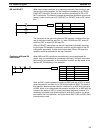
28
4-3-1 Basic Terms
Each condition in a ladder diagram is either ON or OFF depending on the
status of the operand bit that has been assigned to it. A normally open condi-
tion is ON if the operand bit is ON; OFF if the operand bit is OFF. An normally
closed condition is ON if the operand bit is OFF; OFF if the operand bit is
ON. Generally speaking, you use a normally open condition when you want
something to happen when a bit is ON and an normally closed condition
when you want something to happen when a bit is OFF.
Instruction
Instruction
0000
0000
Instruction is executed
when IR 0000 is ON.
Instruction is executed
when IR 0000 is OFF.
Normally open condition
Normally closed condition
In ladder diagram programming, the logical combination of ON and OFF con-
ditions before an instruction determines the compound condition under which
the instruction is executed. This condition, which is either ON or OFF, is
called the execution condition for the instruction. All instructions except for
LOAD instructions have execution conditions.
The operands designated for any of the ladder instructions can be any bit in
the IR, SR, HR or TC area. This means that the conditions in a ladder dia-
gram can be determined by I/O bits, flags, work bits, timers/counters, etc.
LOAD and OUTPUT instructions can also use TR area bits, but they do so
only in special applications.
What conditions correspond to what instructions is determined by the rela-
tionship between the conditions established by the instruction lines that con-
nect them. Any group of conditions that go together to create a logic result is
called a logic block. Although ladder diagrams can be written without actually
analyzing individual logic blocks, understanding logic blocks is necessary for
efficient programming and is essential when programs are to be input in mne-
monic code.
4-3-2 Mnemonic Code
The ladder diagram cannot be directly input into the PC via a Programming
Console; a GPC, a FIT, or LSS is required. To input from a Programming
Console, it is necessary to convert the ladder diagram to mnemonic code.
The mnemonic code provides exactly the same information as the ladder dia-
gram, but in a form that can be typed directly into the PC. Actually you can
program directly in mnemonic code, although it in not recommended for be-
ginners or for complex programs. Also, regardless of the Programming De-
vice used, the program is stored in memory in mnemonic form, making it im-
portant to understand mnemonic code.
Because of the importance of the Programming Console as a peripheral de-
vice and because of the importance of mnemonic code in complete under-
standing of a program, we will introduce and describe the mnemonic code
along with the ladder diagram. Remember, you will not need to use the mne-
monic code if you are inputting via a GPC, a FIT, or LSS (although you can
use it with these devices too, if you prefer).
Normally Open and
Normally Closed
Conditions
Execution Conditions
Operand Bits
Logic Blocks
The Ladder Diagram Section 4-3


















